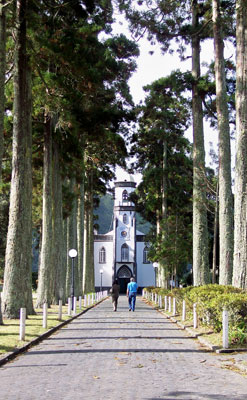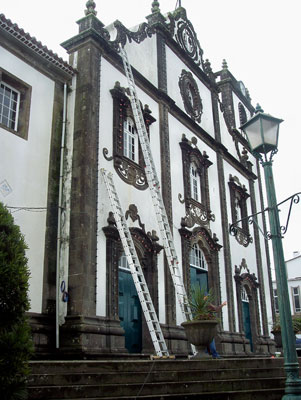The bounty of Saõ Miguel
This item appears on page 75 of the May 2009 issue.
(Part 2 of 2 on the Azores)
The second portion of my November ’08 sojourn to the Portuguese Azores with my wife, Gail, focused on the capital city of Ponta Delgada and the main island of São Miguel. The three days we spent on the island, hosted by Azores Express and the Azores tourist office, resulted in our having a capsule view of a lifestyle we found to be enviable.
Arriving in Ponta Delgada on our interisland flight from Pico in late afternoon, we were met by our guide for the next three days, Eduardo Almeida. He would prove to be exemplary and the key to our fast-paced exploration of São Miguel. From the moment we met, touring with Eduardo was more like traveling with a knowledgeable friend than a guide.
We learned that it was the flourishing orange trade that first brought the isolated Azores into prominence in the 19th century by providing the high-demand citrus delicacy for England and other European centers. The industry, unfortunately, was decimated by disease in the 1880s and never recovered, although citrus is grown for local consumption today.
Eduardo told us that São Miguel now has a population of 133,000, a bit over half of the total population of the Azores.
We first went to a viewpoint at the Church of All Saints for a panoramic view of Ponta Delgada, which became the capital of the Azores in 1546. Over the years, the city has grown and developed around a natural bay on the rugged southern coastline. Today it reflects an interesting mixture of the myriad European architectural styles and evolving urban planning that have influenced its history.
Ponta Delgada’s range of preserved historic buildings and other attractions is easily worth a couple of days of dedicated exploring. Our brief introductory driving tour of the main part of the city later evolved into a walking tour of the main commercial district.
We were accommodated at Hotel Avenida, which was centrally located in the heart of the business district, one building in from the waterfront and perfectly situated for exploring on foot. The Avenida staff proved to be friendly and helpful. Room rates start at $140.
Our first evening, we continued walking in the city, soaking up the sights and sounds before stopping for dinner at an unpretentious popular local haunt, Bella Italia, where our two dinners consisting of seafood pasta, pizza, salad and beer cost a total of $52.
Touring marathon beckons
First-time visitors to São Miguel, we quickly realized that there was too much to see and do in the few days we had allotted. Therefore, of necessity, our pace would be rather relentless.
Our first morning on the island, we ventured inland to visit Caldera Velha, hiking in to see the warm mineral springs which are so popular with locals on weekends and during the summer.
On São Miguel we would continuously marvel at the profusion of beautiful, immaculately maintained public parks, picnic areas and hiking trails. The Azoreans today truly acknowledge the scenic bounty for which they are the beneficial custodians, with a serious commitment to protecting and preserving the verdant natural environment.
Tea for two
We continued to and along the north coast, stopping for a fascinating educational visit at the Gorreana Tea Factory, producing quality teas since 1883. Tea production was introduced in the Azores in 1820 with seeds from Brazil, and at its height of prominence 14 factories were in operation.
The industry declined over the years due to a number of economic factors, and today Gorreana is one of the two remaining operations. Gorreana still produces 40 tons of tea annually, 20% of which is exported to the USA and Canada.
En route to our midday destination, Furnas, Eduardo advised us that numerous varieties of camellias are grown in the Azores, and each year an international camellia conference is hosted there attended by camellia aficionados from around the globe.
The Azores produce a very high-quality milk, enhanced by the low-stress component experienced by the local dairy cows. Why are the cows less stressed? The dairy farmers transport portable milking machines to the cows in the field for twice-a-day milking. If one must be a dairy cow, this is definitely the place to be.
Furnas — caldera of Eden
We entered the enormous crater which is the Furnas Valley, a giant garden of plantings from diverse regions around the world. It is crossed by two rivers, one hot and one cold, and graced by 22 thermal springs. Furnas village is an important thermal center, where the sulfuric waters and muds from the geysers are used in the treatment of respiratory infections and a variety of other ailments.
We raced to Furnas Lake just in time to see traditional cozido — baskets of vegetables (typically kale and cabbage), potatoes and meats cooked by steam for about seven hours — being pulled from the boiling lakeside hand-dug calderas. Wandering up close in this minefield of bubbling pools of mud reminded us both of past thermal adventures in Rotorua, New Zealand.
In Furnas I enjoyed a swim in the warm mineral pools at the famed, historic, recently refurbished Terra Nostra Garden Hotel. This was followed by a lunch in which Gail partook of the cozido option. She reported the blending of flavors to be a unique culinary experience. Regretfully, we did not have time to explore the highly touted gardens on the property.
Continuing our exploration of Furnas, we sampled many of the 22 varieties of mineral water available in a series of public fountains. Two or three were particularly tasty and refreshing. Locals, as a practice, fill large water bottles with their preferred choices for daily consumption.
Our route homeward included a diversion to Ribeira Grande, a typical coastal fishing village with an appealing beach. It was interesting being a fly-on-the-wall observer, even if briefly.
North coast touring
We began early the next morning because we had a lot of ground to cover on our north coast itinerary. At our first stop, Eduardo took us on a walking tour of Ribeira Grande, an attractive town which was developed around the nearly 500-year-old Our Lady of the Star Church, rebuilt in 1736.
At Parque Natural de Ribeira, yet another idyllic mountain grotto of waterfalls, streams and walking trails, we observed corn flour being produced using a traditional watermill.
Nordeste and beyond
The perpetually scenic, winding north coast road continued on to the Nordeste region, a rugged combine of steep mountains, deep valleys, rivers and, jutting out into the sea, peninsulas extraordinaire.
The inviting Nordeste village is a summertime base for hikers wishing to explore the numerous walking trails. The region offers a relaxing respite from civilization for all and is regarded by many to be the best-kept secret on the island.
We continued on to Povoacão, site of the first Portuguese settlement in the Azores in 1432. Today it features a pleasant town square and old streets which travel down to the harbor front.
Stopping for a predarkness view overlooking Villa Franco do Campo, we experienced more of the banana groves and vineyards that thrive in the ideal microclimate growing conditions on the south coast near Ponta Delgada.
Evening at the mall
In the evening, back in Ponta Delgada we decided to visit the city’s main modern shopping mall, Centro Comercial, which, to our surprise, was quite stylish and open until 11 p.m. At one end was one of the city’s two large, impressive Hipermarket supermarkets. We had simply not expected to find this degree of modern convenience in the Azores.
Sete Cidades beckons
Early on our final morning we ventured on foot with Eduardo to the local markets, where we were able to view the extensive range of fruits and vegetables grown on the island. The tangerines were exquisite. The adjacent fish markets displayed the wide range of fish caught in local waters.
On this day we were westward bound to explore Sete Cidades, a 12-kilometer crater cradling twin lakes, one blue and one green, perhaps the most photographed destination in the Azores. The interior of the crater is a protected conservation area featuring peaceful pastures, unending gardens of hydrangeas in most seasons, magnificent banks of trees and the peaceful enclave of Sete Cidades.
A stop at a local café provided an opportunity to sample two local delicacies — quail eggs and spiced beans — both served as a no-charge accompaniment to whatever else you are having. We had five cappuccinos, a beer and a donut plus our complimentary eggs and beans for just under $5. The local beer, Especial, was one of the best I have ever tasted. Eduardo told me the water makes the difference.
Continuing on, the road traversed the hillside and finally reached the famous viewpoint overlooking the tranquil twin lakes and most of the crater from which the famed postcard photos are taken. The intermittent rains, however, played havoc with our photo ops.
In late afternoon we toured a local pineapple factory, learning about this truly amazing island industry. Originally cultivated from Brazilian stock, pineapples have been raised in lowrise hothouses in the Azores since the 1850s. The growing cycle to cultivation is a lengthy 24 months.
Azorean pineapples are uniquely tasty and a bit more acidic than tropical varieties. In addition to fresh pineapples being provided for local consumption as well as limited export to mainland Portugal, pineapple liqueurs and other products are produced.
Eduardo arranged a final peaceful stroll through tranquil Antonio Borges Park, where we were able to reflect on our week-long whirlwind romance with the Azores before departing for the airport.
Azores information
For information concerning travel to the Azores, contact the Portuguese National Tourism Office (New York, NY; 800/767-8842, ext. 3, www.visitportugal.com). Azores Express (800/762-9995, www.sata.pt) flies nonstop to the Azores from Boston, MA; Providence, RI, and Oakland, CA. ITN
You may write to Randy at 80 America Way, Jamestown, RI 02835, or e-mail [email protected].
Keck's Beyond the Garden Wall
❝Where the human experiment thrives
in harmony with the natural world
Symbiosis extraordinaire ❞
— Randy reflecting on the essence of the Azores


